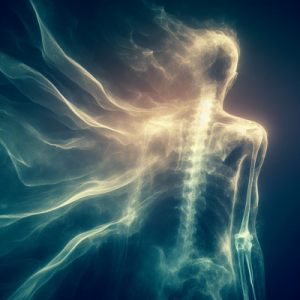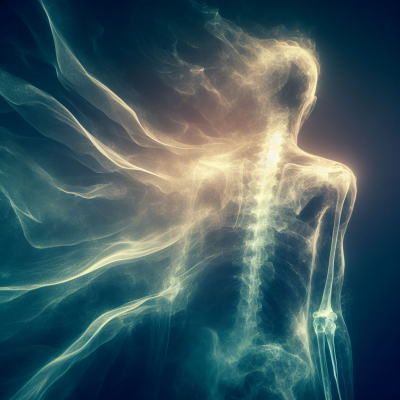Do you know that more than 85% of amputees experience phantom limb pain?
If you or someone you know is haunted by these ghostly aches, this article is for you.
Discover how science and soul come together to tame the pain of phantom limbs.
From innovative neuromodulation techniques to the healing power of acupuncture and traditional medicine, explore the various ways in which you can find relief and reclaim your life.
Key Takeaways
 Mirror therapy and virtual reality therapy are effective techniques for managing phantom limb pain by creating the illusion of movement and engaging the brain in activities involving the missing limb.
Mirror therapy and virtual reality therapy are effective techniques for managing phantom limb pain by creating the illusion of movement and engaging the brain in activities involving the missing limb.- Acupuncture and transcutaneous electrical nerve stimulation (TENS) are alternative therapies that can provide pain relief and relaxation for individuals with phantom limb pain.
- Neuroplasticity plays a crucial role in the development of phantom sensations and understanding the brain’s ability to reorganize itself is essential for developing effective treatments.
- Advances in neuromodulation, such as spinal cord stimulation (SCS) and deep brain stimulation (DBS), have revolutionized pain management techniques and have shown promising results in relieving chronic pain conditions.
The Mystery of Phantom Limb Pain
Are you curious about the enigmatic nature of phantom limb pain and the profound impact it can have on those who experience it?
Phantom limb pain is a perplexing phenomenon that occurs when individuals who’ve undergone amputations still feel sensations in their missing limbs. These phantom limb sensations can range from mild tingling to excruciating pain, making it a challenging condition to manage.
While the exact cause of phantom limb pain remains unknown, medical professionals have been exploring various alternative therapies to help alleviate the discomfort and improve the quality of life for those affected.
One alternative therapy that has shown promise in managing phantom limb pain is mirror therapy. This technique involves placing a mirror in such a way that the reflection of the intact limb appears to be the missing limb. By moving the intact limb while watching its reflection, it tricks the brain into perceiving movement in the phantom limb, reducing pain and promoting neural reorganization.
Another alternative therapy that has gained attention is virtual reality therapy. By immersing individuals in a virtual environment, they can engage in activities that involve their phantom limb. This not only distracts the brain from the pain but also helps retrain the neural pathways associated with the missing limb, potentially reducing phantom limb sensations.
Other alternative therapies being explored include acupuncture, transcutaneous electrical nerve stimulation (TENS), and cognitive-behavioral therapy (CBT). Acupuncture targets specific points in the body to promote pain relief and relaxation. TENS involves the use of low-voltage electrical currents to stimulate the nerves and alleviate pain. CBT focuses on changing negative thought patterns and behaviors, helping individuals better cope with phantom limb pain.
While there’s still much to learn about the enigmatic nature of phantom limb pain, alternative therapies offer hope for managing the discomfort and improving the well-being of those living with this condition. By continuously researching and exploring new treatment approaches, medical professionals strive to provide effective and compassionate care for individuals experiencing phantom limb sensations.
The Science Behind Phantom Sensations
If you’ve ever wondered about the scientific explanation behind phantom sensations, you’ll be fascinated to discover the complex processes that occur in the brain and nervous system. One key factor in understanding phantom sensations is the concept of neuroplasticity. Neuroplasticity refers to the brain’s ability to reorganize itself in response to changes in the environment or the body.
When a limb is amputated, the brain undergoes a series of changes to adapt to the new reality. The area of the brain that used to receive sensory input from the missing limb begins to reorganize and form new connections. This rewiring can lead to the sensation of a phantom limb, where the amputee feels as though the limb is still present, and even experiences pain or other sensations in the absent limb.
To alleviate phantom sensations, researchers have developed sensory substitution techniques. These techniques involve using other sensory modalities to provide feedback to the brain. For example, an amputee may wear a device that uses vibrations or electrical stimulation to provide tactile sensations to the remaining limb. This sensory input helps to rewire the brain and reduce the sensation of the phantom limb.
In addition to sensory substitution techniques, other approaches such as mirror therapy and virtual reality have shown promise in reducing phantom sensations. These methods work by providing visual feedback that tricks the brain into perceiving movement or sensation in the missing limb.
Understanding the science behind phantom sensations is crucial in developing effective treatments for individuals experiencing phantom limb pain. By harnessing the brain’s neuroplasticity and using sensory substitution techniques, researchers are making strides in alleviating the ghostly aches that haunt amputees.
Unveiling the Role of the Brain in Phantom Limb Pain
Discover how your brain plays a crucial role in experiencing phantom limb pain. Through the use of advanced brain imaging techniques, scientists have been able to unravel the mysteries of this perplexing phenomenon. These imaging studies have revealed that the brain is a central player in generating and maintaining phantom limb pain.
Neuroplasticity, the brain’s ability to reorganize and adapt, is thought to be a key factor in the development of phantom limb pain. When a limb is amputated, the sensory input from that limb is no longer received by the brain. In response, the brain undergoes a process of reorganization, where the areas previously dedicated to processing input from the amputated limb become adapted for other functions. However, this reorganization can sometimes lead to the misinterpretation of signals, resulting in the perception of pain in the missing limb.
Brain imaging studies have shown that areas of the brain responsible for processing sensory information, such as the somatosensory cortex, can become hyperactive in individuals experiencing phantom limb pain. This hyperactivity may contribute to the persistent pain experienced by amputees. Additionally, changes in brain connectivity patterns have been observed, suggesting that alterations in the communication between different brain regions may also play a role in phantom limb pain.
Understanding the role of the brain in phantom limb pain has important implications for the development of effective treatment strategies. By targeting specific areas of the brain involved in the generation of phantom limb pain, interventions such as transcranial magnetic stimulation and neurofeedback training have shown promising results in alleviating this debilitating condition. Furthermore, the concept of neuroplasticity offers hope for the possibility of rewiring the brain and reducing the perception of pain.
Innovations in Neuromodulation for Pain Relief
You can explore the latest innovations in neuromodulation for pain relief. Neuromodulation advancements have revolutionized pain management techniques, offering hope to those suffering from chronic pain conditions. Through the use of electrical stimulation or targeted drug delivery, neuromodulation techniques aim to modify the activity of the nervous system to alleviate pain.
One significant innovation in neuromodulation is spinal cord stimulation (SCS). This technique involves the implantation of a small device near the spinal cord, which delivers electrical impulses to disrupt pain signals. SCS has shown promising results in relieving chronic back and leg pain, allowing patients to regain control of their lives.
Another exciting advancement is deep brain stimulation (DBS), which involves the placement of electrodes in specific areas of the brain to modulate abnormal neural activity. While initially developed for movement disorders like Parkinson’s disease, DBS has also shown efficacy in managing chronic pain conditions. By stimulating targeted areas of the brain, DBS can help alleviate pain and improve quality of life.
Furthermore, researchers are exploring the use of neurostimulation techniques, such as transcranial magnetic stimulation (TMS) and transcutaneous electrical nerve stimulation (TENS), for pain relief. TMS uses magnetic fields to stimulate specific regions of the brain, while TENS delivers low-level electrical currents to the skin. Both methods have shown promise in reducing pain perception and improving overall well-being.
Innovations in neuromodulation provide a ray of hope for individuals living with chronic pain. These advancements offer personalized and targeted approaches to pain management, allowing individuals to regain control and find relief. As scientists continue to explore and refine these techniques, the future looks promising for those seeking effective and long-lasting pain relief.
Harnessing the Power of Virtual Reality Therapy
Immerse yourself in the world of virtual reality therapy, and experience the power of this innovative treatment for phantom limb pain. Virtual reality applications have emerged as a groundbreaking tool in the field of pain management, providing individuals with a unique and immersive therapy experience.
Here are four key ways in which virtual reality therapy is harnessing its power to alleviate the suffering caused by phantom limb pain:
-
Distraction: Virtual reality therapy offers a captivating and interactive environment that diverts your attention away from the sensation of phantom limb pain. By engaging your senses with virtual landscapes and activities, it helps to break the cycle of pain signals being sent to your brain.
-
Mirror Therapy: Through virtual reality, mirror therapy can be enhanced to provide a more realistic and immersive experience. By placing a virtual limb in the place of the missing limb, mirror therapy can trick your brain into perceiving movement and reducing the phantom limb pain.
-
Motor Imagery: Virtual reality therapy allows you to visualize and practice movements that may be challenging due to the absence of a limb. By mentally rehearsing these movements in a virtual environment, you can retrain your brain and improve motor function, leading to a reduction in phantom limb pain.
-
Psychotherapeutic Techniques: Virtual reality therapy can incorporate psychotherapeutic techniques such as cognitive-behavioral therapy and mindfulness. By guiding you through relaxation exercises, stress reduction techniques, and positive affirmations, it aims to alleviate the psychological distress often associated with phantom limb pain.
Exploring Non-Invasive Techniques for Phantom Limb Pain
To gain a deeper understanding of phantom limb pain and explore potential solutions, delve into the realm of non-invasive techniques and discover the promising advancements in this field. Non-pharmacological interventions have become a focal point in the management of phantom limb pain, offering hope to those who suffer from this debilitating condition.
One key area of exploration in non-invasive techniques is the mind-body connection. Researchers have discovered that by harnessing the power of the mind, individuals can alleviate phantom limb pain and improve their quality of life. Techniques such as meditation, mindfulness, and hypnosis have shown promising results in reducing pain intensity and frequency.
Meditation, for example, allows individuals to focus their attention and cultivate a state of relaxation. By directing their thoughts away from the pain and towards a peaceful state, individuals can experience a reduction in phantom limb pain. Similarly, mindfulness practices promote non-judgmental awareness of the present moment, helping individuals detach from the sensations of pain and find relief.
Hypnosis, on the other hand, taps into the power of suggestion and imagination. By guiding individuals into a relaxed state, a skilled hypnotherapist can suggest that the phantom limb is no longer in pain. This technique has been shown to decrease pain perception and provide temporary relief.
Furthermore, non-invasive techniques such as mirror therapy and transcutaneous electrical nerve stimulation (TENS) have also shown promise in managing phantom limb pain. Mirror therapy involves the use of a mirror to create an illusion of movement in the phantom limb. This technique helps rewire the brain and alleviate pain. TENS, on the other hand, uses low-voltage electrical currents to stimulate the nerves in the affected area, providing pain relief.
Integrating Mindfulness and Meditation for Healing
Tap into the power of mindfulness and meditation to integrate healing practices into your daily routine, relieving phantom limb pain and promoting overall well-being. By incorporating mindfulness techniques and meditation practices, you can find peace and relief from the ghostly aches that persist after the loss of a limb.
Here are four ways to integrate mindfulness and meditation into your healing journey:
-
Mindful Breathing: Take a few moments each day to focus on your breath. Close your eyes and bring your attention to the sensation of the breath entering and leaving your body. Notice the rise and fall of your chest and the sensation of the breath flowing in and out. This simple practice can help bring you into the present moment, calming your mind and reducing the intensity of phantom limb pain.
-
Body Scan Meditation: Lie down in a comfortable position and slowly scan your body from head to toe, bringing attention to each part. Notice any sensations or tension you may feel. As you bring awareness to your phantom limb, imagine sending healing energy to that area. By bringing conscious attention to your body, you can begin to alleviate the pain and discomfort associated with phantom limb sensations.
-
Loving-Kindness Meditation: Engage in a loving-kindness meditation practice to cultivate compassion and empathy towards yourself and others. Begin by silently repeating phrases such as ‘May I be free from suffering. May I be at peace.’ Gradually extend these wishes to loved ones, acquaintances, and even those who’ve caused you pain. This practice can help shift your focus away from the phantom limb pain and towards a more positive and compassionate mindset.
-
Mindful Movement: Engage in gentle movement practices such as yoga or tai chi, focusing on the sensations in your body as you move. Pay attention to how your body feels and any changes in your phantom limb sensations. Incorporating mindful movement into your routine can help improve flexibility, reduce pain, and promote overall well-being.
The Healing Power of Acupuncture and Traditional Medicine
When it comes to finding relief from phantom limb pain, you can explore the healing power of acupuncture and traditional medicine. Traditional practices have been used for centuries to address various ailments, and they continue to play a significant role in modern approaches to healthcare.
Acupuncture, a key component of traditional medicine, involves the insertion of thin needles into specific points on the body. This ancient practice is believed to restore the flow of energy, or Qi, within the body, promoting healing and relieving pain. Acupuncture has been found to be particularly effective in managing phantom limb pain, offering relief to those who’ve exhausted other treatment options.
One theory behind the effectiveness of acupuncture is that it stimulates the release of endorphins, the body’s natural painkillers. By targeting specific points along the body’s meridians, acupuncture can help regulate the nervous system and reduce pain signals. This holistic approach not only addresses the physical symptoms but also considers the emotional and spiritual aspects of healing.
In addition to acupuncture, other traditional practices such as herbal medicine and massage therapy can also provide relief from phantom limb pain. Herbal remedies, carefully selected and prescribed by experienced practitioners, can help reduce inflammation and alleviate discomfort. Massage therapy, on the other hand, can improve blood circulation, relax tense muscles, and promote overall well-being.
While traditional medicine may not be the first approach that comes to mind when seeking relief from phantom limb pain, it offers a holistic perspective that considers the interconnectedness of the body, mind, and spirit. By exploring these traditional practices alongside modern approaches, you can find a comprehensive treatment plan that addresses your unique needs and provides lasting relief from phantom limb pain.
Understanding the Emotional and Psychological Impact of Phantom Limb Pain
Explore how phantom limb pain can deeply affect your emotions and psychology, causing a complex array of feelings and challenges to navigate. Dealing with phantom limb pain goes beyond the physical discomfort, as it also has a significant impact on your emotional well-being and psychological state.
Here are four key aspects to consider when understanding the emotional and psychological impact of phantom limb pain:
-
Grief and Loss: The absence of a limb can evoke a profound sense of loss and grief. It’s natural to mourn the loss of a body part and the abilities it once provided. Coping with this grief requires emotional resilience and support from loved ones.
-
Anxiety and Depression: Phantom limb pain can lead to feelings of anxiety and depression. Constant pain and the inability to perform everyday tasks may cause a sense of helplessness and frustration. Seeking professional help and engaging in therapy can aid in managing these psychological challenges.
-
Body Image and Identity: Adjusting to life with a missing limb can alter your perception of self and body image. It may take time to accept and embrace these changes. Surrounding yourself with a supportive community and participating in activities that promote body positivity can help rebuild confidence and self-esteem.
-
Exploring Alternative Therapies: Traditional medicine may not always offer complete relief from phantom limb pain. Exploring alternative therapies such as mindfulness, meditation, and biofeedback can provide additional tools for managing the emotional and psychological aspects of phantom limb pain. These approaches focus on calming the mind, reducing stress, and promoting overall well-being.
Navigating the Path to Relief: Finding Support and Resources
You’ll need to reach out to various resources and support networks to find the help and assistance you need to navigate the path to relief from phantom limb pain. Finding support and accessing resources are crucial steps in managing this condition effectively.
One of the first places to start is with your healthcare provider. They can provide guidance and refer you to specialists who’ve experience in treating phantom limb pain. These professionals can offer a range of treatments, including medications, physical therapy, and psychological counseling. They can also provide information on support groups and community resources that can enhance your journey towards relief.
Support groups can be invaluable in helping you navigate the challenges of phantom limb pain. Connecting with others who’ve experienced similar struggles can provide a sense of validation and understanding. Hearing about their coping strategies and success stories can inspire hope and offer practical advice. Online forums and social media groups can also serve as a platform for finding support and accessing resources, allowing you to connect with individuals from around the world who are going through similar experiences.
Furthermore, there are a variety of resources available to assist you in managing phantom limb pain. Websites, books, and educational materials can provide valuable information about the condition, its causes, and possible treatment options. These resources can empower you to make informed decisions about your healthcare and give you a deeper understanding of your own experiences.
Frequently Asked Questions
How Common Is Phantom Limb Pain?
Phantom limb pain is a common experience for many people who’ve lost a limb. It occurs when you feel pain or discomfort in a limb that’s no longer there. The prevalence of phantom limb pain varies, but it’s estimated that around 60-80% of amputees experience this phenomenon.
Factors such as the type of amputation, the length of time since the amputation, and individual differences in pain perception can influence the occurrence and severity of phantom limb pain.
Can Phantom Limb Pain Be Cured Completely?
Yes, phantom limb pain can be cured completely. Thanks to ongoing phantom limb pain research and innovative treatment methods, there’s hope for those suffering from this condition.
By combining scientific advancements with a holistic approach that addresses the soul, doctors are making great strides in alleviating phantom limb pain.
While each case is unique, with the right treatment plan and support, it’s possible to overcome these ghostly aches and regain a sense of normalcy.
Are There Any Medications Specifically Designed to Treat Phantom Limb Pain?
Yes, there are medications specifically designed to treat phantom limb pain. While they may not completely cure it, they can help alleviate the symptoms.
Phantom limb pain research has led to the development of various drugs that target the nerve signals responsible for this condition.
However, it’s important to note that non-pharmacological treatments, such as therapy and prosthetic training, are also effective in managing phantom limb pain.
How Long Does Phantom Limb Pain Typically Last?
Phantom limb pain can vary in duration for each individual. While there’s no set timeframe, it typically lasts for a few months to a few years.
However, there are rehabilitation techniques and management strategies available to help alleviate the pain. These include physical therapy, mirror therapy, cognitive behavioral therapy, and medication.
It’s important to work closely with your healthcare provider to develop a personalized treatment plan that addresses your specific needs and goals.
Can Phantom Limb Pain Affect a Person’s Mental Health?
Phantom limb pain can have a significant impact on your mental health and overall well-being. The constant presence of pain and the inability to find relief can lead to feelings of frustration, anxiety, and depression.
However, there’s hope. Psychological interventions, such as cognitive behavioral therapy and mindfulness techniques, have been shown to be effective in managing phantom limb pain and improving your mental state.
It’s important to seek support and explore these options to find relief and enhance your quality of life.
Conclusion
In the journey to tame the ghostly aches of phantom limb pain, science and soul join forces.
From the groundbreaking advancements in neuromodulation and virtual reality therapy to the ancient wisdom of acupuncture and traditional medicine, a range of approaches offer hope for relief.
Understanding the emotional and psychological impact of this pain is crucial, and finding support and resources is essential.
Like a compass guiding us through unknown terrain, these tools and connections light our path towards healing.









